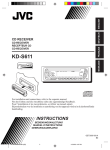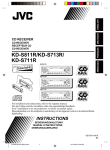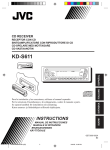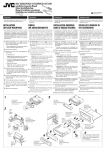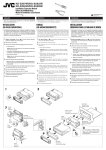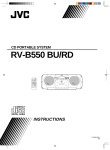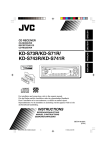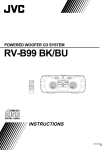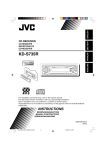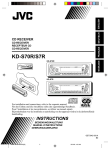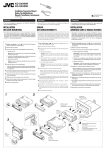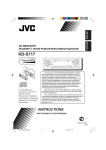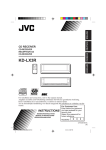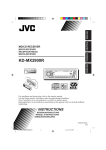Download JVC KD-S9R User's Manual
Transcript
ENGLISH DEUTSCH CD RECEIVER FRANÇAIS CD-RECEIVER RECEPTEUR CD CD-RECEIVER NEDERLANDS KD-S9R 45Wx4 /I / ATT MO RND DISP RDS SSM TP RPT PTY 7 8 9 10 11 12 SCM AM FM CD For installation and connections, refer to the separate manual. Für den Einbau und die Anschlüsse siehe das eigenständige Handbuch. Pour l’installation et les raccordements, se référer au manuel séparé. Bijzonderheden over de installatie en aansluiting van het apparaat vindt u in de desbetreffende handleiding. INSTRUCTIONS BEDIENUNGSANLEITUNG MANUEL D’INSTRUCTIONS GEBRUIKSAANWIJZING GET0007-001A [E] COVER.KD-S9R[E].001A 3 9/28/00, 5:57 PM ENGLISH Position And Reproduction Of Labels Bottom panel of the main unit DANGER: Invisible laser radiation when open and interlock failed ordefeated. AVOID DIRECTEXPOSURE TO BEAM. (e) ADVARSEL:Usynlig laserstråling ved åbning, når sikkerhedsafbrydere erude af funktion. Undgåudsættelse for stråling. (d) VARNING:Osynliglaserstrålning när denna del är öppnadoch spärren är urkopplad. Betrakta ej strålen. (s) VARO: Avattaessa ja suojalukitus ohitettaessa olet alttiina näkymättömälle lasersäteilylle. Älä katso säteeseen. (f) IMPORTANT FOR LASER PRODUCTS Name/Rating plate Caution: This product contains a laser component of higher laser class than Class 1. Precautions: 1.CLASS 1 LASER PRODUCT 2.DANGER: Invisible laser radiation when open and interlock failed or defeated. Avoid direct exposure to beam. 3.CAUTION: Do not open the top cover. There are no user-serviceable parts inside. Leave all servicing to qualified service personnel. 4.CAUTION: This CD player uses invisible laser radiation and is equipped with safety switches to prevent radiation emission when unloading CDs. It is dangerous to defeat the safety switches. 5.CAUTION: Use of controls, adjustments or performance of procedures other than those specified herein may result in hazardous radiation exposure. How to reset your unit Press and hold both the SEL (select) and time for several seconds. This will reset the built-in microcomputer. (standby/on/attenuator) buttons at the same (standby/on/attenuator) SEL (select) Notes: • Your preset adjustments — such as preset channels or sound adjustments — will also be erased. • If a CD is in the unit, “PLEASE” and “EJECT” appear on the display alternately. In this case, press 0 to eject the CD. Pay attention not to drop the CD. * When you reset the unit with no CD loaded… After you open and close the control panel, nothing may be displayed although the unit is on. In this case, press to return to the normal state. 2 EN02-03.KD-S9R[E]f 2 9/19/00, 9:21 AM Thank you for purchasing a JVC product. Please read all instructions carefully before operation, to ensure your complete understanding and to obtain the best possible performance from the unit. How to reset your unit ............................... 2 LOCATION OF THE BUTTONS ............ 4 Control panel ........................................... 4 BASIC OPERATIONS ...................... 5 Turning on the power ................................ 5 RADIO BASIC OPERATIONS ............. 6 Listening to the radio ................................ Storing stations in memory ....................... Tuning into a preset station ....................... 6 7 8 RDS OPERATIONS ........................ 9 What you can do with RDS EON .............. Other convenient RDS functions and adjustments ........................................... 9 ENGLISH CONTENTS SOUND ADJUSTMENTS .................. 17 Adjusting the sound ................................. Using the sound control memory ............. Storing your own sound adjustments ....... 17 17 18 OTHER MAIN FUNCTIONS ............... 19 Setting the clock ...................................... 19 Changing the general settings (PSM) ...... 19 Detaching the control panel ...................... 22 TROUBLESHOOTING...................... 23 MAINTENANCE ............................ 24 Handling CDs .......................................... 24 SPECIFICATIONS .......................... 25 12 CD OPERATIONS .......................... 14 Playing a CD ............................................ Locating a track or a particular portion on a CD ......................................................... Selecting CD playback modes .................. Playing a CD Text .................................... Prohibiting CD ejection ............................. 14 15 15 16 16 Note: For security reasons, a numbered ID card is provided with this unit, and the same ID number is imprinted on the unit’s chassis. Keep the card in a safe place, as it will help the authorities to identify your unit if stolen. BEFORE USE *For safety.... • Do not raise the volume level too much, as this will block outside sounds, making driving dangerous. • Stop the car before performing any complicated operations. EN02-03.KD-S9R[E]f 3 *Temperature inside the car.... If you have parked the car for a long time in hot or cold weather, wait until the temperature in the car becomes normal before operating the unit. 3 9/20/00, 9:06 AM ENGLISH LOCATION OF THE BUTTONS Control panel Display window u o i s df 1 2 3 4 ; g h j 5 k 6 7 8 9 /I / ATT MO RND DISP RDS SSM TP RPT PTY 7 8 9 10 11 12 AM SCM p q w e 1 (standby/on/attenuator) button 2 Control dial 3 DISP (display) button 4 TP (traffic programme) RDS (radio data system) button 5 PTY (programme type) button 6 RPT (repeat) button 7 MO (monaural) button RND (random) button 8 0 (eject) button 9 4/ ¢ buttons • Also functions as SSM buttons when pressed together. p (control panel release) button q SEL (select) button w SCM (sound control memory) button e Number buttons r AM button t FM button y CD button r CD FM t y Display window u Volume level indicator i RDS indicators TP, PTY, EON, AF, REG o Main display ; Tuner reception indicators STEREO, MONO a “Link” indicator s RPT (repeat) indicator d RND (random) indicator f CD IN indicator g Source/clock display h LOUD indicator j Equalization pattern indicator k Sound mode indicators SOFT, BEAT, POP 4 EN04-04.KD-S9R[E]f 4 a 9/20/00, 9:06 AM ENGLISH BASIC OPERATIONS /I / ATT MO RND DISP RDS SSM TP RPT PTY 7 8 9 10 11 12 AM SCM 1 3 4 Adjust the sound as you want (see page 17). Turn on the power. /I / ATT To drop the volume in a moment Note on One-Touch Operation: When you select a source in step 2 below, the power automatically comes on. You do not have to press this button to turn on the power. 2 Select the source. AM To turn off the power CD FM Press briefly while listening to any source. “ATT” starts flashing on the display, and the volume level will drop in a moment. To resume the previous volume level, press the button briefly again. • If you rotate the control dial clockwise, you can also restore the sound. Press and hold To operate the tuner (AM or FM), see pages 6 – 13. To operate the CD player, see pages 14 – 16. 3 CD 2 Turning on the power 1 FM Adjust the volume. To increase the volume. To decrease the volume. for more than 1 second. Note: When you use this unit for the first time, set the built-in clock correctly, see page 19. CAUTION on Volume Setting CDs produce very little noise compared with other sources. If the volume level is adjusted for the tuner, for example, the speakers may be damaged by the sudden increase in the output level. Therefore, lower the volume before playing a disc and adjust it as required during playback. Volume level appears. Volume level indicator 5 EN05-05.KD-S9R[E]f 5 9/19/00, 9:21 AM ENGLISH RADIO BASIC OPERATIONS /I / ATT MO RND DISP RDS SSM TP RPT PTY 7 8 9 10 11 12 AM SCM Listening to the radio You can use either automatic searching or manual searching to tune into a particular station. CD FM To stop searching before a station is received, press the same button you have pressed for searching. Searching a station automatically: Auto search Searching a station manually: Manual search 1 1 Select the band (AM, FM1 – 3). Select the band (AM, FM1 – 3). AM AM F1 AM FM FM F2 F1 F3 AM (FM1) (FM2) (FM3) F2 F3 (FM1) (FM2) (FM3) Note: This receiver has three FM bands (FM1, FM2, FM3). You can use any one of them to listen to an FM broadcast. Selected band (or clock time: see page 21) appears. Audio (see page 21) or volume level indicator 2 Press and hold ¢ or 4 until “MANU” (manual) starts flashing on the display. Note: This receiver has three FM bands (FM1, FM2, FM3). You can use any one of them to listen to an FM broadcast. 2 Selected band appears. Start searching a station. Press ¢ to search stations of higher frequencies. Press 4 to search stations of lower frequencies. When a station is received, searching stops. 6 EN06-08.KD-S9R[E]f 6 9/19/00, 9:22 AM Tune into a station you want while “MANU” is flashing. Press ¢ to search stations of higher frequencies. Press 4 to search stations of lower frequencies. • If you release your finger from the button, the manual mode will automatically turn off after 5 seconds. • If you hold down the button, the frequency keeps changing (in 50 kHz intervals for FM and 9 kHz intervals for AM – MW/LW) until you release the button. Storing stations in memory You can use one of the following two methods to store broadcasting stations in memory. • Automatic preset of FM stations: SSM (Strongstation Sequential Memory) • Manual preset of both FM and AM stations FM station automatic preset: SSM You can preset 6 local FM stations in each FM band (FM1, FM2 and FM3). 1 Select the FM band (FM1 – 3) you want to store FM stations into. • Each time you press the button, the FM band changes as follows: FM When an FM stereo broadcast is hard to receive: Press MO RND (monaural/random) while listening to an FM stereo broadcast. • Each time you press the button, the MONO indicator lights up and goes off alternately. ENGLISH 3 F1 F2 F3 (FM1) (FM2) (FM3) 2 Press and hold both buttons for more than 2 seconds. SSM MO RND Lights up when receiving an FM broadcast in stereo. When the MONO indicator is lit on the display, the sound you hear becomes monaural but the reception will be improved (the STEREO indicator goes off). “SSM” appears, then disappears when automatic preset is over. Local FM stations with the strongest signals are searched and stored automatically in the band number you have selected (FM1, FM2 or FM3). These stations are preset in the number buttons — No.1 (lowest frequency) to No.6 (highest frequency). When automatic preset is over, the station stored in number button 1 will be automatically tuned in. 7 EN06-08.KD-S9R[E]f 7 9/19/00, 9:22 AM ENGLISH Manual preset You can preset up to 6 stations in each band (FM1, FM2, FM3 and AM) manually. Ex: Storing an FM station of 88.3 MHz into the preset number 1 of the FM1 band 1 Select the FM band (FM1 – 3) you want to store FM stations into (in this example, FM1). • Each time you press the button, the FM band changes as follows: FM F1 F2 F3 (FM1) (FM2) (FM3) 2 Tune into a station of 88.3 MHz. Notes: • A previously preset station is erased when a new station is stored in the same preset number. • Preset stations are erased when the power supply to the memory circuit is interrupted (for example, during battery replacement). If this occurs, preset the stations again. Tuning into a preset station You can easily tune into a preset station. Remember that you must store stations first. If you have not stored them yet, see “Storing stations in memory” on page 7. 1 Select the band (AM, FM1 – 3). AM F1 Press ¢ to tune in stations of higher frequencies. Press 4 to tune in stations of lower frequencies. 3 FM AM 2 Press and hold the number button (in this example, 1) for more than 2 seconds. Repeat the above procedure to store other stations into other preset numbers. 8 EN06-08.KD-S9R[E]f 8 F3 Select the number (1 – 6) for the preset station you want. Band/preset number and “MEMO” flash alternately for a while. 4 F2 (FM1) (FM2) (FM3) 9/19/00, 9:22 AM RDS OPERATIONS RDS (Radio Data System) allows FM stations to send an additional signal along with their regular programme signals. For example, the stations send their station names, as well as information about what type of programme they broadcast, such as sports or music, etc. Another advantage of RDS function is called “EON (Enhanced Other Networks).” The EON indicator lights up while receiving an FM station with the EON data. By using the EON data sent from a station, you can tune into a different station of a different network broadcasting your favorite programme or traffic announcement while listening to another programme or to another source such as CD. By receiving the RDS data, this unit can do the following: • Tracing the same programme automatically (Network-Tracking Reception) • Standby Reception of TA (Traffic Announcement) or your favorite programme • PTY (Programme Type) search • Programme search • And some other functions Tracing the same programme automatically (Network-Tracking Reception) When driving in an area where FM reception is not good, the tuner built in this unit automatically tunes into another RDS station, broadcasting the same programme with stronger signals. So, you can continue to listen to the same programme in its finest reception, no matter where you drive. (See the illustration on the next page.) Two types of the RDS data are used to make Network-Tracking Reception work correctly — PI (Programme Identification) and AF (Alternative Frequency). Without receiving these data correctly from the RDS station you are listening to, Network-Tracking Reception will not operate. To use Network-Tracking Reception, press and hold TP RDS (Traffic Programme/Radio Data System) for more than 1 second. Each time you press and hold the button, Network-Tracking Reception modes change as follows: ENGLISH What you can do with RDS EON RDS TP AF indicator Mode 1 Mode 2 Mode 3 REG indicator Mode 1 The AF indicator lights up but the REG indicator does not. Network-Tracking Reception is activated with Regionalization set to “off.” Switches to another station within the same network when the receiving signals from the current station become weak. • In this mode, the programme may differ from the one currently received. Mode 2 Both the AF indicator and the REG indicator light up. Network-Tracking Reception is activated with Regionalization set to “on.” Switches to another station, within the same network, broadcasting the same programme when the receiving signals from the current station become weak. Mode 3 Neither the AF indicator nor the REG indicator lights up. Network-Tracking Reception is deactivated. 9 EN09-13.KD-S9R[E]f 9 9/19/00, 9:22 AM ENGLISH The same programme can be received on different frequencies. Programme 1 broadcasting on frequency A Programme 1 broadcasting on frequency B Programme 1 broadcasting on frequency E Programme 1 broadcasting on frequency C Programme 1 broadcasting on frequency D Using Standby Reception Standby Reception allows the unit to switch temporarily to your favorite programme (PTY: Programme Type) and Traffic Announcement (TA) from the current source (another FM station and CD) • Standby Reception will not work if you are listening to an AM station. TA Standby Reception RDS TP When you press TP RDS while listening to an FM station, the TP indicator is lit during reception of a TP (Traffic Programme) station and the TA standby mode is engaged. • When the station being received is not a TP station, the TP indicator flashes. Press ¢ or 4 to engage the TA standby mode. “SEARCH” appears on the display, and TP station search starts. When a TP station is tuned in, the TP indicator is lit. 7 If you are listening to a CD and wish to listen to a TP station, press TP RDS to enter the TA standby mode. (The TP indicator lights up.) To deactivate the TA standby mode, press TP RDS again. PTY Standby Reception PTY When you press PTY while listening to an FM station, the PTY indicator is lit during reception of a PTY station and the PTY standby mode is engaged. The selected PTY name stored on page 11 flashes for 5 seconds. • When the station being received is not a PTY station, the PTY indicator flashes. Press ¢ or 4 to engage the PTY standby mode. “SEARCH” appears on the display, and PTY station search starts. When a PTY station is tuned in, the PTY indicator is lit. 7 If you are listening to a CD and wish to listen to a selected PTY broadcast, press PTY to enter the PTY standby mode. (The PTY indicator lights up.) If the selected PTY programme starts broadcasting while the PTY standby mode is active, the selected PTY name appears and the playback source changes to the FM band. The selected PTY programme can then be heard. To deactivate the PTY standby mode, press PTY again. Selecting your favorite programme for PTY Standby Reception You can select your favorite programme for PTY Standby Reception to store in memory. When shipped from the factory, “NEWS” is stored as the programme type for PTY Standby Reception. 1 Press and hold SEL (select) for more than 2 seconds so that one of the PSM items appears on the display. (PSM: see page 20.) If a traffic programme starts broadcasting while the TA standby mode is active, “TRAFFIC” appears and the playback source changes to the FM band. The volume increases to the preset TA volume level (see page 13) and the traffic programme can be heard. 10 EN09-13.KD-S9R[E]f 10 9/19/00, 9:22 AM 3 Select “PTY STBY” (standby) if not shown on the display. Select one of twenty-nine PTY codes. Selected code name appears on the display and is stored into memory. • For details, see the table below. 4 Searching your favorite programme You can search one of your 6 favorite programme types stored in memory. When shipped from the factory, the following 6 programme types have been stored in the number buttons (1 to 6). To store your favorite programme types, see below. To search your favorite programme type, see page 12. 2 ROCK M 3 EASY M 4 CLASSICS 5 AFFAIRS 6 VARIED To store your favorite programme types 1 Finish the setting. 1 POP M ENGLISH 2 Press and hold SEL (select) for more than 2 seconds so that one of the PSM items appears on the display. (PSM: see page 20.) CONTINUED ON THE NEXT PAGE PTY codes NEWS: AFFAIRS: News Topical programmes expanding on current news or affairs INFO: Programmes which impart advice on a wide variety of topics SPORT: Sport events EDUCATE: Educational programmes DRAMA: Radio plays CULTURE: Programmes on national or regional culture SCIENCE: Programmes on natural science and technology VARIED: Other programmes like comedies or ceremonies POP M: Pop music ROCK M: Rock music EASY M: Easy-listening music LIGHT M: Light music CLASSICS: Classical music OTHER M: Other music WEATHER: Weather information FINANCE: Reports on commerce, trading, the Stock Market, etc. CHILDREN: Entertainment programmes for children SOCIAL: RELIGION: PHONE IN: TRAVEL: LEISURE: JAZZ: COUNTRY: NATION M: OLDIES: FOLK M: DOCUMENT: Programmes on social activities Programmes dealing with any aspect of belief or faith, or the nature of existence or ethics Programmes where people can express their views either by phone or in a public forum Programmes about travel destinations, package tours, and travel ideas and opportunities Programmes concerned with recreational activities such as gardening, cooking, fishing, etc. Jazz music Country music Current popular music from another nation or region, in that country’s language Classic pop music Folk music Programmes dealing with factual matters, presented in an investigative style 11 EN09-13.KD-S9R[E]f 11 9/19/00, 9:22 AM ENGLISH 2 Select “PTY SRCH” (search) if not shown on the display. 2 Select one of PTY codes stored in preset number buttons (1 to 6). PTY search for your favorite programme starts after 5 seconds. 3 Select one of twenty-nine PTY codes. (See page 11.) Selected code name appears on the display. • If the code already stored in memory is selected, it will flash on the display. 4 Press and hold the number button for more than 2 seconds to store the PTY code selected into the preset number you want. PTY preset number appears, and selected code name and “MEMORY” alternate on the display. 5 • If there is a station broadcasting a programme of the same PTY code you selected, that station is tuned in. • If there is no station broadcasting a programme of the same PTY code you selected, the station will not change. Note: In some areas, the PTY search will not work correctly. Other convenient RDS functions and adjustments Automatic selection of the station when using the number buttons Finish the setting. To search your favorite programme type 1 Ex. When “ROCK M” is stored in preset number button 2 Press and hold PTY (programme type) for more than 1 second while listening to an FM station. Usually when you press the number button, the preset station is tuned in. However, when the preset station is an RDS station, something different will happen. If the signals from that preset station are not sufficient for good reception, this unit, using the AF data, tunes in another frequency broadcasting the same programme as the original preset station is broadcasting. (Programme search) PTY The last selected PTY code and preset number appear. 12 EN09-13.KD-S9R[E]f 12 9/19/00, 9:22 AM 1 Press and hold SEL (select) for more than 2 seconds so that one of the PSM items appears on the display. 2 Press ¢ or 4 to select “P(Programme)-SEARCH.” 3 Rotate the control dial clockwise to select “ON.” Now programme search is activated. To cancel programme search, repeat the same procedure and select “OFF” in step 3 by rotating the control dial counterclockwise. Setting the TA volume level You can preset the volume level for TA Standby Reception. When a traffic programme is received, the volume level automatically changes to the preset level. • See also “Changing the general settings (PSM)” on page 19. ENGLISH To activate programme search, follow the procedure below. • Programme search takes a while. • See also “Changing the general settings (PSM)” on page 19. 1 Press and hold SEL (select) for more than 2 seconds so that one of the PSM items appears on the display. 2 Press ¢ or 4 to select “TA VOL.” 3 Rotate the control dial to set to the desired volume. You can set it from “VOL 00” to “VOL 50.” Automatic clock adjustment Changing the display mode while listening to an FM station You can change the initial indication on the display to either station name (PS NAME) or to station frequency (FREQ), while listening to an FM RDS station. • See also “Changing the general settings (PSM)” on page 19. 1 Press and hold SEL (select) for more than 2 seconds so that one of the PSM items appears on the display. 2 Press ¢ or 4 to select “TU DISP (tuner display).” 3 Rotate the control dial to set to the desired indication (“PS NAME” or “FREQ”). Note: By pressing DISP, you can also change the display while listening to an FM RDS station. Each time you press the button, the following information appears on the display: Station name Station frequency (PS NAME) (FREQ) Programme type (PTY) When shipped from the factory, the clock built in this unit is set to be readjusted automatically using the CT (Clock Time) data in the RDS signal. If you do not want to use automatic clock adjustment, follow the procedure below. • See also “Changing the general settings (PSM)” on page 19. 1 Press and hold SEL (select) for more than 2 seconds so that one of the PSM items appears on the display. 2 Press ¢ or 4 to select “AUTO ADJ.” 3 Rotate the control dial counterclockwise to select “OFF.” Now automatic clock adjustment is canceled. To reactivate clock adjustment, repeat the same procedure and select “ON” in step 3 by rotating the control dial clockwise. Note: It takes about 2 minutes to adjust the time using the CT data. So, you should not change the station for more than 2 minutes continuously; otherwise, the clock time will not be adjusted. • Then, the display goes back to the original indication in several seconds. 13 EN09-13.KD-S9R[E]f 13 9/19/00, 9:22 AM ENGLISH CD OPERATIONS /I / ATT MO RND DISP RDS SSM TP RPT PTY 7 8 9 Playing a CD 1 Open the control panel. Note on One-Touch Operation: When a CD is already in the loading slot, pressing CD turns on the unit and starts playback automatically. 2 Insert a disc into the loading slot. The unit turns on, draws a CD and starts playback automatically. 3 Close the control panel by hand. The CD IN indicator lights up. Total playing time of the inserted disc 10 11 12 AM SCM Total track number of the inserted disc Elapsed playing time FM CD Notes: • When a CD is inserted upside down, “PLEASE” and “EJECT” appear on the display alternately. When you open the control panel by pressing 0, the CD automatically ejects. • When you play a CD Text, the disc title and performer appear on the display. Then the current track and elapsed playing time appears on the display. See also “Playing a CD Text” (page 16) and “To select the scroll mode – SCROLL” (page 21). If a CD Text includes much text information, some may not appear on the display. To stop play and eject the CD Press 0. CD play stops, the control panel opens, then the CD automatically ejects from the loading slot. If you change the source to FM or AM, the CD play also stops (without ejecting the CD this time). Notes: • If the ejected disc is not removed for about 15 seconds, the disc is automatically inserted again into the loading slot to protect it from dust. (CD play will not start this time.) • You can eject the CD even when the unit is turned off. Current track 14 EN14-16.KD-S9R[E]f 14 9/19/00, 9:23 AM Play) To fast-forward or reverse the track Press and hold ¢, while playing a CD, to fast-forward the track. Press and hold 4, while playing a CD, to reverse the track. You can play back all tracks on the CD at random. Each time you press MO RND (monaural/ random) while playing a CD, CD random play mode turns on and off alternately. MO RND To go to the next tracks or the previous tracks ¢ briefly, while Press playing a CD, to go ahead to the beginning of the next track. Each time you press the button consecutively, the beginning of the next tracks is located and played back. Press 4 briefly, while playing a CD, to go back to the beginning of the current track. Each time you press the button consecutively, the beginning of the previous tracks is located and played back. To go to a particular track directly 7 8 9 10 11 ENGLISH Locating a track or a particular Selecting CD playback modes portion on a CD To play back tracks at random (Random The RND indicator When the random mode is turned on, the RND indicator lights up on the display and a track randomly selected starts playing. To play back tracks repeatedly (Repeat Play) You can play back the current track repeatedly. Each time you press RPT (repeat) while playing a CD, CD repeat play mode turns on and off alternately. RPT Track number of the currently playing track The RPT indicator 12 When the repeat mode is turned on, the RPT indicator lights up on the display. Press the number button corresponding to the track number to start its playback. • To select a track number from 1 – 6: Press 1 (7) – 6 (12) briefly. • To select a track number from 7 – 12: Press and hold 1 (7) – 6 (12) for more than 1 second. 15 EN14-16.KD-S9R[E]f 15 9/19/00, 9:23 AM ENGLISH Playing a CD Text Prohibiting CD ejection In a CD Text, some information about the disc (its disc title, performer and track title) is recorded. You can show these disc information on the display. You can prohibit CD ejection and can lock a CD in the loading slot. Select text display mode while playing a CD Text. While pressing CD, press and hold for more than 2 seconds. CD /I / ATT DISP Each time you press the button, the display changes as follows: Disc Title / Performer Track Title “NO EJECT” flashes on the display for about 5 seconds, and the CD is locked and cannot be ejected. To cancel the prohibition and unlock the CD, press again for more than 2 seconds, while pressing CD. Current track and Elapsed playing time Notes: • The display shows up to 8 characters at one time and scrolls if there are more than 8 characters. See also “To select the scroll mode – SCROLL” on page 21. Some characters or symbols will not be shown (and be blanked) on the display. (Ex. “ABCå!d#” ]“ABCA D ”) • When you press DISP (display) while playing a conventional CD, “NO NAME” appears for the disc title/performer and the track title. “EJECT OK” flashes on the display for about 5 seconds, and the CD is unlocked. 16 EN14-16.KD-S9R[E]f 16 9/19/00, 9:23 AM 2 Adjusting the sound Adjust the level. To increase the level. You can adjust the sound characteristics to your preference. 1 Select the item you want to adjust. ENGLISH SOUND ADJUSTMENTS To decrease the level. Each time you press the button, the adjustable items change as follows: BAS (treble) VOL LOUD (volume) Indication FAD TRE (bass) (fader) (balance) (loudness) To do: Adjust the bass. –06 (min.) | +06 (max.) TRE Adjust the treble. –06 (min.) | +06 (max.) FAD* Adjust the front and rear speaker balance. R06 (Rear only) | F06 (Front only) BAL Adjust the left and right speaker balance. L06 (Left only) | R06 (Right only) VOL Boost low and high frequencies to produce a wellbalanced sound at low volume level. Adjust the volume. Note: Normally the control dial works for volume adjustment. So you do not have to select “VOL” to adjust the volume level. Range BAS LOUD Equalization pattern changes as you adjust the bass or treble. BAL LOUD ON | LOUD OFF 00 (min.) | 50 (max.) * If you are using a two-speaker system, set the fader level to “00.” Using the sound control memory You can select and store a preset sound adjustment suitable for each playback source. (Advanced SCM) Selecting and storing the sound modes Once you select a sound mode, it is stored in memory. It will be recalled every time you select the same source and will be shown on the display. A sound mode can be stored for each of the following sources — FM1, FM2, FM3, AM and CD. • If you do not want to store the sound mode separately for each playback source, but want to use the same sound mode for all the sources, see “To cancel Advanced SCM – SCM LINK” on page 21. Select the sound mode you want. SCM "Link" indicator Each time you press the button, the sound mode changes as follows: BEAT SOFT POP SCM OFF 17 EN17-18.KD-S9R[E]f 17 9/19/00, 9:23 AM ENGLISH • If the “Link” indicator is lit on the display (with “SCM LINK” set to “LINK ON” — see page 21), the selected sound mode can be stored in memory for the current source, and the effect applies to the current source. • If the “Link” indicator is NOT lit on the display (with “SCM LINK” set to “LINK OFF”), the selected sound mode effect applies to any source. Indication For: BEAT Rock or disco music SOFT Quiet background music POP Light music SCM OFF (Flat sound) Preset values BAS TRE LOUD +02 00 ON Storing your own sound adjustments You can adjust the sound modes (BEAT, SOFT, POP) to your preference and store your own adjustments in memory. • There is a time limit in doing the following procedure. If the setting is canceled before you finish, start from step 1 again. 1 Call up the sound mode you want to adjust. • See the left column for details. +01 –03 OFF +04 00 +01 00 OFF ON SCM 2 Select “BAS” (Bass), “TRE” (Treble) or “LOUD” (Loudness). Recalling the sound modes 3 Select the source while the “Link” indicator is lit on the display. AM FM • See page 17 for details. CD The “Link” indicator starts flashing, and the sound mode stored in memory for the selected source is recalled. Equalization pattern of the selected sound mode appears. Adjust the bass or treble level or turn the loudness function ON/OFF. Sound mode indicator 4 5 Press and hold SCM until the sound mode you have selected in step 1 flashes on the display. Your adjustment made for the selected sound mode is stored in memory. LOUD (loudness) indicator Notes: • You can adjust each sound mode to your preference, and store it in memory. If you want to adjust and store your original sound mode, see “Storing your own sound adjustments” on the right column. • To adjust the bass and treble reinforcement levels or to turn on/off the loudness function temporarily, see page 17. (Your adjustments will be canceled if another source is selected.) Repeat steps 2 and 3 to adjust the other items. SCM 6 Repeat the same procedure to store other sound modes. To reset to the factory settings Repeat the same procedure and reassign the preset values listed in the table on the left column. 18 EN17-18.KD-S9R[E]f 18 9/19/00, 9:23 AM Setting the clock You can also set the clock system to either 24 hours or 12 hours. 1 2 Press and hold SEL (select) for more than 2 seconds so that one of the PSM items appears on the display. (See page 20.) 1 2 Set the minute. 5 Basic Procedure 1 2 3 1 Select “CLOCK M.” 2 Adjust the minute. 2 1 4 You can change the items listed on the next page by using the PSM (Preferred Setting Mode) control. Press and hold SEL (select) for more than 2 seconds so that one of the PSM items appears on the display. (See page 20.) Set the hour. 1 Select “CLOCK H” if not shown on the display. 2 Adjust the hour. 3 Changing the general settings (PSM) ENGLISH OTHER MAIN FUNCTIONS Set the clock system. 4 1 Select “24H/12H.” 2 Select “24H” or “12H.” 2 1 5 Select the PSM item you want to adjust. (See page 20.) Adjust the PSM item selected above. Repeat steps 2 and 3 to adjust the other PSM items if necessary. Finish the setting. Finish the setting. To check the current clock time while the unit is turned off, press DISP (display). The power turns on, the clock time is shown for 5 seconds, then the power turns off. 19 EN19-22.KD-S9R[E]f 19 9/19/00, 9:23 AM ENGLISH Preferred Setting Mode (PSM) items 1 2 3 Factorypreset settings Set. Counterclockwise Hold. Select. CLOCK H Hour adjustment Back Advance CLOCK M Minute adjustment Back Advance SCM LINK Sound control memory linkage LINK OFF 24H/12H 24/12-hour time display AUTO ADJ See page Clockwise 0:00 19 LINK ON LINK ON 18, 21 12H 24H 24H 19 Automatic clock setting OFF ON ON 13 CLOCK Clock display OFF ON ON 21 TU DISP Tuner display FREQ PS NAME PS NAME 13 PTY STBY PTY standby 10 PTY SRCH PTY search 29 programme types (see page 11.) NEWS (See page 11.) 11 TA VOL Traffic announcement volume VOL 00 – VOL 50 VOL 20 13 P-SEARCH Programme search OFF 13 LEVEL Level display AUDIO 2 21 OFF 21 ONCE 21 OFF ON AUDIO 2 AUDIO 1 OFF TEL Telephone muting MUTING 2 MUTING 1 OFF SCROLL Name display ONCE AUTO OFF • Press SEL (select) to finish the setting. 20 EN19-22.KD-S9R[E]f 20 9/19/00, 9:24 AM To select the telephone muting – TEL You can cancel the Advanced SCM (Sound Control Memory), and unlink the sound modes and the playback sources. When shipped from the factory, a different sound mode can be stored in memory for each source so that you can change the sound modes simply by changing the sources. This mode is used when a cellular phone system is connected. Depending on the phone system used, select either “MUTING 1” or “MUTING 2,” whichever mutes the sounds from this unit. When shipped from the factory, this mode is deactivated. • LINK ON: Advanced SCM (different sound modes for different sources) • LINK OFF: Conventional SCM (one sound mode for all sources) ENGLISH To cancel Advanced SCM – SCM LINK • MUTING 1: Select this if this setting can mute the sounds. • MUTING 2: Select this if this setting can mute the sounds. • OFF: Cancels the telephone muting. To select the scroll mode – SCROLL To set the clock display – CLOCK You can set the clock to be shown on the display when the unit is turned on. When shipped from the factory, the clock is set to be shown on the display. You can select the scroll mode for the name display and disc information if it consists of more than 8 characters. When shipped from the factory, scroll mode is set to “ONCE.” • ON: • OFF: • ONCE: • AUTO: Clock display is turned on. Clock display is turned off. When “OFF” is selected, the current source name or station band appears instead of the clock display. To check the other information during play Press DISP (display). Each time you press the button, the other information (either the clock or the source name) will be shown on the lower part of the display for a while. • OFF: Scrolls only once. Repeats the scroll (5-second intervals in between). Cancels the scroll mode. Note: Even if the scroll mode is set to “OFF,” you can scroll the display by pressing DISP for more than 1 second. To select the level meter – LEVEL You can select the level display according to your preference. When shipped from the factory, “AUDIO 2” is selected. • AUDIO 1: • AUDIO 2: • OFF: Shows the audio level indicator and the equalization pattern indicator. Alternates “AUDIO 1” setting and illumination display. Erases the audio level indicator and the equalization pattern indicator. 21 EN19-22.KD-S9R[E]f 21 9/19/00, 9:24 AM ENGLISH Detaching the control panel You can detach the control panel when leaving the car. When detaching or attaching the control panel, be careful not to damage the connectors on the back of the control panel and on the panel holder. Attaching the control panel 1 Insert the right side of the control panel into the groove on the panel holder. Detaching the control panel Before detaching the control panel, be sure to turn off the power. 1 Unlock the control panel. 2 Pull the control panel out of the unit. 3 Put the detached control panel into the provided case. 2 Press the left side of the control panel to fix it to the panel holder. Note on cleaning the connectors: If you frequently detach the control panel, the connectors will deteriorate. To minimize this possibility, periodically wipe the connectors with a cotton swab or cloth moistened with alcohol, being careful not to damage the connectors. Connectors 22 EN19-22.KD-S9R[E]f 22 9/19/00, 9:24 AM What appears to be trouble is not always serious. Check the following points before calling a service center. Symptoms Causes Remedies • CD cannot be played back. CD is inserted upside down. Insert the CD correctly. • CD sound is sometimes interrupted. You are driving on rough roads. Stop playing CD while driving on rough roads. The disc is scratched. Change the disc. Connections are incorrect. Check the cords and connections. • Sound is sometimes interrupted. Connections are incorrect. Check the cords and connections. • Sound cannot be heard from the speakers. The volume is turned to the minimum level. Adjust it to the optimum level. Connections are incorrect. Check the cords and connections. • SSM (Strong-station Sequential Memory) automatic preset does not work. Signals are too weak. Store stations manually. • Static noise while listening to the radio. The antenna is not connected firmly. Connect the antenna firmly. • “NO DISC” appears on the display. No CD is inserted. Insert a CD correctly. • CD cannot be ejected. CD is locked. Unlock the CD (see page 16). • CD can be neither played back nor ejected. The unit may function incorrectly. Press and hold both CD and SEL at the same time for several seconds. (“PLEASE” and “EJECT” appear on the display alternately.) When you open the control panel by pressing 0, be careful not to drop CD when it is ejected. • This unit does not work at all. The built-in microcomputer may function incorrectly due to noise, etc. Press and hold both SEL and at the same time for several seconds to reset the unit. (The clock setting and preset stations stored in memory are erased.) (See page 2.) ENGLISH TROUBLESHOOTING 23 EN23-25.KD-S9R[E]f 23 9/19/00, 9:24 AM ENGLISH MAINTENANCE Handling CDs Moisture condensation This unit has been designed only to reproduce the CDs bearing the following marks. COMPACT DIGITAL AUDIO • Other discs cannot be played back. How to handle CDs Moisture may condense on the lens inside the CD player in the following cases: • After starting the heater in the car. • If it becomes very humid inside the car. Should this occur, the CD player may malfunction. In this case, eject the CD and leave the unit turned on for a few hours until the moisture evaporates. Center holder When removing a CD from its case, press down the center holder of the case and lift the CD out, holding it by the edges. • Always hold the CD by the edges. Do not touch its recording surface. When storing a CD into its case, gently insert the CD around the center holder (with the printed surface facing up). • Make sure to store CDs into the cases after use. To keep CDs clean A dirty CD may not play correctly. If a CD does become dirty, wipe it with a soft cloth in a straight line from center to edge. When playing a CD-R (Recordable) You can play back your original CD-Rs on this receiver. • Before playing back CD-Rs, read their instructions or cautions carefully. • Some CD-Rs recorded on CD recorders may not be played back on this receiver because of their disc characteristics, and of the following reasons: – Discs are dirty or scratched. – Moisture condensation occurs on the lens inside the unit. – The pickup lens inside the CD player is dirty. • Use only “finalized” CD-Rs. • CD-RWs (Rewritable) cannot be played back on this receiver. • Do not use CD-Rs with stickers or sticking labels on the surface. They may cause malfunctions. CAUTIONS: • Do not insert 8 cm CDs (single CDs) into the loading slot. (Such CDs cannot be ejected.) • Do not insert any CD of unusual shape — like a heart or flower; otherwise, it will cause a malfunction. • Do not expose CDs to direct sunlight or any heat source or place them in a place subject to high temperature and humidity. Do not leave them in a car. • Do not use any solvent (for example, conventional record cleaner, spray, thinner, benzine, etc.) to clean CDs. To play new CDs New CDs may have some rough spots around the inner and outer edges. If such a CD is used, this unit may reject the CD. To remove these rough spots, rub the edges with a pencil or ball-point pen, etc. About mistracking: Mistracking may result from driving on extremely rough roads. This does not damage the unit and the CD, but will be annoying. We recommend that you stop CD play while driving on such rough roads. 24 EN23-25.KD-S9R[E]f 24 9/19/00, 9:24 AM AUDIO AMPLIFIER SECTION CD PLAYER SECTION Maximum Power Output: Front: 45 W per channel Rear: 45 W per channel Continuous Power Output (RMS): Front: 17 W per channel into 4 Ω, 40 Hz to 20 000 Hz at no more than 0.8% total harmonic distortion. Rear: 17 W per channel into 4 Ω, 40 Hz to 20 000 Hz at no more than 0.8% total harmonic distortion. Load Impedance: 4 Ω (4 Ω to 8 Ω allowance) Tone Control Range: Bass: ±10 dB at 100 Hz Treble: ±10 dB at 10 kHz Frequency Response: 40 Hz to 20 000 Hz Signal-to-Noise Ratio: 70 dB Line-Out Level/Impedance: 2.0 V/20 kΩ load (full scale) Output Impedance: 1 kΩ Type: Compact disc player Signal Detection System: Non-contact optical pickup (semiconductor laser) Number of channels: 2 channels (stereo) Frequency Response: 5 Hz to 20 000 Hz Dynamic Range: 96 dB Signal-to-Noise Ratio: 98 dB Wow and Flutter: Less than measurable limit ENGLISH SPECIFICATIONS GENERAL Power Requirement: Operating Voltage: DC 14.4 V (11 V to 16 V allowance) Grounding System: Negative ground Allowable Operating Temperature: 0°C to +40°C Dimensions (W × H × D): Installation Size: 182 mm × 52 mm × 160 mm Panel Size: 188 mm × 58 mm × 8 mm Mass: 1.7 kg (excluding accessories) TUNER SECTION Frequency Range: FM: 87.5 MHz to 108.0 MHz AM: (MW) 522 kHz to 1 620 kHz (LW) 144 kHz to 279 kHz Design and specifications subject to change without notice. [FM Tuner] Usable Sensitivity: 11.3 dBf (1.0 µV/75 Ω) 50 dB Quieting Sensitivity: 16.3 dBf (1.8 µV/75 Ω) Alternate Channel Selectivity (400 kHz): 65 dB Frequency Response: 40 Hz to 15 000 Hz Stereo Separation: 30 dB Capture Ratio: 1.5 dB [MW Tuner] Sensitivity: 20 µV Selectivity: 35 dB [LW Tuner] Sensitivity: 50 µV 25 EN23-25.KD-S9R[E]f 25 9/19/00, 9:24 AM Having TROUBLE with operation? Please reset your unit Refer to page of How to reset your unit Haben Sie PROBLEME mit dem Betrieb? Bitte setzen Sie Ihr Gerät zurück Siehe Seite Zurücksetzen des Geräts Vous avez des PROBLÈMES de fonctionnement? Réinitialisez votre appareil Référez-vous à la page intitulée Comment réinitialiser votre appareil Hebt u PROBLEMEN met de bediening? Stel het apparaat terug Zie de pagina met de paragraaf Het apparaat terugstellen VICTOR COMPANY OF JAPAN, LIMITED EN, GE, FR, NL COVER.KD-S9R[E].001A V J 2 C 0900MNMMDWJES 9/28/00, 5:57 PM KD-S9R Installation/Connection Manual Einbau/Anschlußanleitung Manuel d’installation/raccordement GET0007-003A [E] V J ENGLISH DEUTSCH C 0900MNMMDWJES EN, GE, FR FRANÇAIS • This unit is designed to operate on 12 V DC, NEGATIVE ground electrical systems. • Dieses Gerät ist für einen Betrieb in elektrischen Anlagen mit 12 V Gleichstrom und (–) Erdung ausgelegt. • Cet appareil est conçu pour fonctionner sur des sources de courant continu de 12 V à masse NEGATIVE. INSTALLATION (IN-DASH MOUNTING) EINBAU (IM ARMATURENBRETT) INSTALLATION (MONTAGE DANS LE TABLEAU DE BORD) • The following illustration shows a typical installation. However, you should make adjustments corresponding to your specific car. If you have any questions or require information regarding installation kits, consult your JVC IN-CAR ENTERTAINMENT dealer or a company supplying kits. • Die folgende Abbildung zeigt einen typischen Einbau. Dennoch müssen Sie entsprechend Ihrem jeweiligen Auto Anpassungen vornehmen. Bei irgendwelchen Fragen oder wenn Sie Informationen hinsichtlich des Einbausatzes brauchen, wenden Sie sich an ihren JVC Autoradiohändler oder ein Unternehmen das diese Einbausätze vertreibt. • L’illustration suivante est un exemple d’installation typique. Cependant, vous devez faire les ajustements correspondant à votre voiture particulière. Si vous avez des questions ou avez besoin d’information sur des kits d’installation, consulter votre revendeur d’autoradios JVC ou une compagnie d’approvisionnement. 1 Before mounting: Press (Control Panel Release button) to detach the control panel. 1 Vor dem Einbau: (Schalttafel-Freigabetaste) zum Lösen der Schalttafel drücken. 2 3 Remove the trim plate. 2 3 Den Frontrahmen herausnehmen. Remove the sleeve after disengaging the sleeve locks. 1 Stand the unit. Fix the mounting bolt to the rear of the unit’s body and place the rubber cushion over the end of the bolt. 6 7 8 Do the required electrical connections. 9 Slide the unit into the sleeve until it is locked. Attach the trim plate so that the projection on the trim plate is fixed to the left side of the unit. Attach the control panel. 4 Die Halterung im Armaturenbrett einbauen. * Nach dem korrekten Einbau der Halterung im Armaturenbrett, die entsprechenden Riegel umknicken, um die Halterung an ihrem Platz zu sichern, siehe Abbildung. Libérer les verrous du manchon et retirer le manchon. Remarque: Lorsque vous mettez l’appareil à la verticale, faire attention de ne pas endommager le fusible situé sur l’arrière. 2 Insérer les 2 poignées entre l’appareil et le manchon comme indiqué pour désengagé les verrous de manchon. 3 Retirer le manchon. Remarque: S’assurer de garder les poignées pour une utilisation ultérieur, après l’installation de l’appareil. 4 Installer le manchon dans le tableau de bord. * Après installation correcte du manchon dans le tableau de bord, plier les bonnes pattes pour maintenir fermement le manchon en place, comme montré. 5 Monter le boulon de montage sur l’arrière du corps de l’appareil puis passer l’amortisseur en caoutchouc sur l’extrémité du boulon. 6 7 Réalisez les connexions électriques. 5 Die Befestigungsschraube an der Rückseite des Gerätekörpers befestigen und das Ende der Schraube mit einem Gummipuffer abdecken. 6 7 8 Nehmen Sie die erforderlichen elektrischen Anschlüsse vor. Befestigen Sie die Frontrahmen in der Form, daß der Fortsatz der Frontrahmen auf der linken Seite des Geräts befestigt wird. 8 Attachez la plaque d’assemblage de façon que la projection de la plaque d’assemblage soit fixée sur le côté gauche de l’appareil. 9 Die Schalttafel anbringen. 9 Remonter le panneau de commande. Das Gerät in die Halterung schieben, bis es einrastet. 1 Faire glisser l’appareil dans le manchon jusqu’à ce qu’il soit verrouillé. 2 Trim plate Frontrahmen Plaque d’assemblage Control Panel Schalttafel Panneau de command 3 Retirer la plaque d’assemblage. 1 Poser l’appareil à la verticale. Hinweis: Sicherstellen, daß die Griffe für künftigen Gebrauch nach dem Einbau des Geräts aufbewahrt werden. Install the sleeve into the dashboard. 5 2 3 Hinweis: Beim Aufstellen des Geräts darauf achten, daß die Sicherung auf der Rückseite nicht beschädigt wird. 2 Die 2 Griffe zwischen dem Gerät und der Halterung wie abgebildet einstecken und die Halterungensperren entriegeln. 3 Die Halterung entfernen. Note: Be sure to keep the handles for future use after installing the unit. * After the sleeve is correctly installed into the dashboard, bend the appropriate tabs to hold the sleeve firmly in place, as illustrated. Avant le montage: Appuyer sur (touche de libération du panneau de commande) pour détacher le panneau de commande. 1 Das Gerät aufstellen. Note: When you stand the unit, be careful not to damage the fuse on the rear. 2 Insert the 2 handles between the unit and the sleeve, as illustrated, to disengage the sleeve locks. 3 Remove the sleeve. 4 Die Halterung nach dem Entriegeln der Halterungensperren abnehmen. 1 Handle Griffe Poignée Rubber cushion Gummipuffer Amortisseur en caoutchouc Lock Plate Arretierplättchen Plaque de verrouillage Slot Schlitz Fente Sleeve Halterung Manchon 4 7 4* 9 Sleeve Halterung Manchon Control Panel Schalttafel Panneau de command Trim plate Frontrahmen Plaque d’assemblage 18 4m m 53 5 mm Mounting bolt Befestigungsschraube Boulon de montage Fuse Sicherung Fusible 8 Dashboard Armaturenbrett Tableau de bord 6 See “ELECTRICAL CONNECTIONS.” Siehe „ELEKTRISCHE ANSCHLÜSSE“. Référez-vous “RACCORDEMENTS ELECTRIQUES”. • When using the optional stay • Beim Verwenden der Anker-Option • Lors de l’utilisation du hauban en option • When installing the unit without using the sleeve • Beim Einbau des Geräts ohne Halterung • Lors de l’installation de l’appareil scans utiliser de manchon In a Toyota for example, first remove the car radio and install the unit in its place. Zum Beispiel in einem Toyota zuerst das Autoradio ausbauen und dann das Gerät an seinem Platz einbauen. Par exemple dans une Toyota, retirer d’abord l’autoradio et installer l’appareil à la place. Fire wall Feuerwand Cloison * Not included with this unit. * Nicht Teil dieses Geräts. * Non fourni avec cet appareil. Flat type screws (M5 x 6 mm)* Senkkopfschrauben (M5 x 6 mm)* Vis à tête plate (M5 x 6 mm)* Dashboard Armaturenbrett Tableau de bord Stay (option) Anker (Option) Hauban (en option) Washer Unterlegscheibe Rondelle Lock nut Sicherungsmutter Ecrou d’arrêt Screw (option) Schraube (Option) Vis (en option) Mounting bolt Befestigungsschraube Boulon de montage Sleeve Halterung Manchon Bracket* Konsole* Support* Pocket Taschen Poche Flat type screws (M5 x 6 mm)* Senkkopfschrauben (M5 x 6 mm)* Vis à tête plate (M5 x 6 mm)* Bracket* Konsole* Support* Note: When installing the unit on the mounting bracket, make sure to use the 6 mm-long screws. If longer screws are used, they could damage the unit. Hinweis: Beim Anbringen des Gerät an der Konsole sicherstellen, daß 6 mm lange Schrauben verwendet werden. Werden längere Schrauben verwendet, können sie das Gerät beschädigen. Remarque: Lors de l’installation de l’appareil sur le support de montage, s’assurer d’utiliser des vis d’une longueur de 6 mm. Si des vis plus longues sont utilisées, elles peuvent endommager l’appareil. Removing the unit Ausbau des Geräts Retrait de l’appareil • Before removing the unit, release the rear section. • Vor dem Ausbau des Geräts den hinteren Teil freigeben. • Avant de retirer l’appareil, libérer la section arrière. 1 2 3 1 2 3 1 2 3 Remove the control panel. Remove the trim plate. Insert the 2 handles into the slots, as shown. Then, while gently pulling the handles away from each other, slide out the unit. (Be sure to keep the handles after installing it.) 1 Die Schalttafel herausnehmen. Den Frontrahmen abnehmen. Die 2 Griffe in die Schlitze wie gezeigt stecken. Dann die Griffe behutsam auseinander ziehen und das Gerät herausziehen. (Die Griffe nach dem Einbau auf jeden Fall aufbewahren.) 2 Control Panel Schalttafel Panneau de command 3 Handle Griff Poignée Trim plate Frontrahmen Plaque d’assemblage Parts list for installation and connection Teileliste für den Einbau und Anschluß The following parts are provided with this unit. After checking them, please set them correctly. Die folgenden Teile werden zusammen mit diesem Gerät geliefert. Nach ihrer Überprüfung, die Teile richtig einsetzen. Hard case Etui Etui de transport Power cord Stromkabel Cordon d’alimentation Sleeve Halterung Manchon Handles Griffe Poignées Retirer le panneau de commande. Retirer la plaque d’assemblage. Introduire les deux poignées dans les fentes, comme montré. Puis, tout en tirant doucement les poignées écartées, faire glisser l’appareil pour le sortir. (S’assurer de conserver les poignées après l’installation de l’appareil.) Liste des pièces pour l’installation et raccordement Les pièces suivantes sont fournies avec cet appareil. Après vérification, veuillez les placer correctement. Trim plate Frontrahmen Plaque d’assemblage Washer (ø5) Unterlegscheibe(ø5) Rondelle (ø5) Lock nut (M5) Sicherungsmutter (M5) Ecrou d’arrêt (M5) Mounting bolt (M5 x 20 mm) Befestigungsschraube (M5 x 20 mm) Boulon de montage (M5 x 20 mm) Rubber cushion Gummipuffer Amortisseur en caoutchouc ENGLISH DEUTSCH FRANÇAIS ELECTRICAL CONNECTIONS ELEKTRISCHE ANSCHLÜSSE RACCORDEMENTS ELECTRIQUES To prevent short circuits, we recommend that you disconnect the battery’s negative terminal and make all electrical connections before installing the unit. If you are not sure how to install this unit correctly, have it installed by a qualified technician. Zur Vermeidung von Kurzschlüssen empfehlen wir, daß Sie den negativen Batterieanschluß abtrennen und alle elektrischen Anschlüsse herstellen, bevor das Gerät eingebaut wird. Sind Sie sich über den richtigen Einbau des Geräts nicht sicher, lassen Sie es von einem qualifizierten Techniker einbauen. Pour éviter tout court-circuit, nous vous recommandons de débrancher la borne négative de la batterie et d’effectuer tous les raccordements électriques avant d’installer l’appareil. Si l'on n’est pas sûr de pouvoir installer correctement cet appareil, le faire installer par un technicien qualifié. Hinweis: Dieses Gerät ist für eine Betrieb in elektrischen Anlagen mit 12 V Gleichstrom und (–) Erdung ausgelegt. Verfügt Ihr Fahrzeug nicht über diese Anlage, ist ein Spannungsinverter erforderlich, der bei JVC Autoradiohändler erworben werden kann. • Die Sicherung mit einer der entsprechenden Nennleistung ersetzen. Brennt die Sicherung häufig durch, wenden Sie sich an ihren JVC Autoradiohändler. • Sind Störgeräusche ein Problem... Dieses Gerät enthält ein Störfilter im Stromkreis. Bei manchen Fahrzeugen kann jedoch ein Klicken oder andere unerwünschte Störgeräusche auftreten. Sollte das der Fall sein, die hintere Erdungscanschlußklemme (siehe Schaltplan) des Geräts am Fahrwerk des Fahrzeugs anschließen, dabei kürzere und dickere Kabel wie beispielsweise Kupfergeflechtdraht oder Stahldraht verwenden. Bleibt Störgeräusch bestehen, wenden Sie sich an Ihren JVC Autoradiohändler. • Maximale Eingangsleistung der Lautsprecher muß höher als 45 W hinten und 45 W vorne sein, mit einer Impedanz von 4 Ω bis 8 Ω. • Sicherstellen, daß das Gerät am Fahrwerk geerdet wird. • Das Abstrahlblech wird nach dem Gebrauch sehr heiß. Beim Ausbau des Geräts darauf achten, das Abstrahlblech nicht zu berühren. Remarque: Cet appareil est conçu pour fonctionner sur des sources de courant continu de 12 V à masse NEGATIVE. Si votre véhicule n’offre pas ce type d’alimentation, il vous faut un convertisseur de tension, que vous pouvez acheter chez un revendeur d’autoradios JVC. • Remplacer le fusible par un de la valeur précisée. Si le fusible saute souvent, consulter votre revendeur d’autoradios JVC. • Si le bruit est un problème... Cet appareil incorpore un filtre de bruit dans le circuit d’alimentation. Cependant, avec certains véhicules, quelques claquements ou autres bruits non désirés risquent de se produire. Si cela arrive, raccorder la borne arrière de masse de l’appareil au châssis de la voiture (voir le diagramme de raccordement) en utiliscant des cordons les plus gros et les plus courts possibles telle qu'une barre de cuivre ou une tresse. Si le bruit persiste, consulter votre revendeur d’autoradios JVC. • La puisscance admissible des haut-parleurs doit être supérieure à 45 W à l’arrière et à 45 W l’avant, avec une impédance de 4 Ω à 8 Ω. • S’assurer de raccorder la mise à la masse de cet appareil au châssis de la voiture. • Le dissipateur de chaleur devient très chaud après usage. Faire attention de ne pas le toucher en retirant cet appareil. Note: This unit is designed to operate on 12 V DC, NEGATIVE ground electrical systems. If your vehicle does not have this system, a voltage inverter is required, which can be purchased at JVC IN-CAR ENTERTAINMENT dealers. • Replace the fuse with one of the specified rating. If the fuse blows frequently, consult your JVC IN-CAR ENTERTAINMENT dealer. • If noise is a problem... This unit incorporates a noise filter in the power circuit. However, with some vehicles, clicking or other unwanted noise may occur. If this happens, connect the unit’s rear ground terminal (see connection diagram) to the car’s chassis using shorter and thicker cords, such as copper braiding or gauge wire. If noise still persists, consult your JVC IN-CAR ENTERTAINMENT dealer. • Maximum input of the speakers should be more than 45 W at the rear and 45 W at the front, with an impedance of 4 Ω to 8 Ω. • Be sure to ground this unit to the car’s chassis. • The heat sink becomes very hot after use. Be careful not to touch it when removing this unit. Heat sink Abstrahlblech Dissipateur de chaleur A Typical Connections / Typische Anschlüsse / Raccordements typiques Vor dem Anschließen: Die Verdrahtung im Fahrzeug sorgfältig überprüfen. Falsche Anschlüsse können ernsthafte Schäden am Gerät hervorrufen. Before connecting: Check the wiring in the vehicle carefully. Incorrect connection may cause serious damage to this unit. 1 Connect the colored leads of the power cord to the car battery, speakers and power aerial (if any) in the following sequence. 1 Die farbigen Leitungen des Spannunsgversorgungskabels an der Autobatterie, den Lautsprechern und dem Motorantenne (sofern vorhanden) in folgender Reihenfolge anschließen. 1 2 3 4 5 Black: ground Yellow: to car battery (constant 12 V) Red: to an accessory terminal Blue with white stripe: to power aerial (200 mA max.) Brown: to cellular phone system (For details, refer to the instructions of the cellular phone.) 6 Others: to speakers 2 3 1 Schwarz: Erdung 2 Gelb: an Autobatterie (konstant 12 V) 3 Rot: an Zubehöranschlußklemme 4 Blau mit weißem Streifen: an Motorantenne (max. 200 mA) 5 Braun: an Mobiltelefon (Weitere informationen entnehmen Sie bitte der Bedienungscanleitung des Mobiltelefons.) 6 Andere: an Lautsprecher Connect the aerial cord. Finally connect the wiring harness to the unit. 2 3 Note: If your vehicle does not have any accessory terminal, move the fuse from the fuse position 1 (initial position) to fuse position 2, and connect the red lead (A7) to the positive (+) battery terminal. • The yellow lead (A4) is not used in this case. Das Antennenkabel anschließen. Die Kabelbäume am Gerät anschließen. Hinweis: Verfügt Ihr Fahrzeug nicht über eine Zubehöranschlußklemme, die Sicherung von der 1. Sicherungsposition (Erstposition) in die 2. Sicherungsposition versetzen, die rote Leitung (A7) an der (+) Batterieanschlußklemme anschließen. • Die gelbe Leitung (A4) wird in diesem Fall nicht verwendet. B1 B3 B2 A2 B2 A2 A4 B6 B8 A5 A7 A6 A8 Yellow*1 Gelb*1 Jaune*1 To aerial Zur Antenne A l’antenne A6 A8 A4 included with this unit. * Not Wird nicht mit Gerät mitgeliefert. 1 2 To metallic body or chassis of the car Zur metallenen Karosserie oder zum Fahrwerk des Autos Vers corps métallique ou châssis de la voiture A7 Blue with white stripe Blau mit weißem Streifen Bleu avec bande blanche White with black stripe Weiß mit schwarzem Streifen Blanc avec bande noire 6 B5 White Weiß Blanc Gray with black stripe Grau mit schwarzem Streifen Gris avec bande noire Left speaker (front) Linker Lautsprecher (vorne) Enceinte gauche (avant) B4 3 Fuse block Sicherungsblock Porte-fusible To an accessory terminal in the fuse block Zur einer Zubehöranschlußklemme im Sicherungsblock Vers borne accessoire du porte-fusible A5 4 To power aerial if any Zur Motorantenne, sofern vorhanden Vers l’antenne automatique, s’il y en a une A2 B3 B8 Gray Grau Gris * * Ignition switch Zündschalter Interrupteur d’allumage To a live terminal in the fuse block connecting to the car battery (bypassing the ignition swich) Zur einer stromführenden Anschlußklemme im Sicherungsblock zum Anschließen an die Autobatterie (Umgehen des Zündschalters) A une borne sous tension du porte-fusible connectée à la batterie de la voiture (en dérivant l’interrupteur d’allumage) Brown / Braun / Marron B6 1 Non fourni avec cet appareil. Red Rot Rouge *1: Before checking the operation of this unit prior to installation, this lead must be connected, otherwise power cannot be turned on. *1: Vor der Überprüfung der Funktionsfähigkeit des Geräts vor dem Einbau, muß diese Leitung angeschlossen werden, da sonst die Stromversorgung nicht eingeschaltet werden kann. *1: Pour vérifier le fonctionnement de cet appareil avant installation, ce fil doit être raccordé, sinon l’appareil ne peut pas être mis sous tension. B8 A7 15 A fuse 15 A Sicherung Fusible 15 A Black Schwarz A8 Noir 3 2 A4 B6 Noir: a la masse Jaune: a la batterie de la voiture (12 V constant) Rouge: à la prise accessoire Bleu avec bande blanche: à l’antenne automatique (200 mA max.) 5 Marron: à un système de téléphone cellulaire (Pour les détails, se référer aux instructions du téléphone cellulaire.) 6 Autres: aux enceintes 2 Connectez le cordon d’antenne. 3 Finalement, connectez le faisceau de fils à l’appareil. Remarque: Si votre véhicule ne possède pas de borne accessoire, déplacez le fusible de la position de fusible 1 (position originale) à la position de fusible 2 et connectez le fil rouge (A7) à la borne positive (+) de la batterie. • Le fil jaune (A4) n’est pas utilisé dans ce cas. Fuse position 2 2. Sicherungsposition Position de fusible 2 Fuse position 1 1. Sicherungsposition Position de fusible 1 B7 A5 1 2 3 4 B7 Aerial terminal Antennenanschlußklemme Borne de l’antenne Rear ground terminal Hintere Erdungscanschlußklemme Borne arrière de masse Line out (see diagram B ) Schutz kappen Signalausgang (siehe Schaltplan B ) Sortie de ligne (voir le diagramme B ) B4 B5 10 B1 B3 B4 B5 Avant de commencer la connexion: vérifiez attentivement le câblage du véhicule. Une connexion incorrecte peut endommager sérieusement l’appareil. 1 Connectez les fils de couleur du cordon d’alimentation à la batterie de la voiture, aux enceintes et à l’antenne automatique (s’il y en a une) dans l’ordre suivant. Green with black stripe Grün mit schwarzem Streifen Vert avec bande noire Right speaker (front) Rechter Lautsprecher (vorne) Enceinte droit (avant) 5 To cellular phone system Zur Moblitelephon À un système de téléphone cellulaire B7 B2 Green Grün Vert Purple with black stripe Lila mit schwarzem Streifen Violet avec bande noire Left speaker (rear) Linker Lautsprecher (hinten) Enceinte gauche (arrière) B1 Purple Lila Violet Right speaker (rear) Rechter Lautsprecher (hinten) Enceinte droit (arrière) PRECAUTIONS on power supply and speaker connections: VORSICHTSMASSREGELN beim Anschließen der Stromversorgung und Lautsprecher: PRECAUTIONS sur l’alimentation et la connexion des enceintes: • DO NOT connect the speaker leads of the power cord to the car battery; otherwise, the unit will be seriously damaged. • Connect the black lead (ground), yellow lead (to car battery, constant 12 V), and red lead (to an accessory terminal) correctly. • BEFORE connecting the speaker leads of the power cord to the speakers, check the speaker wiring in your car. – If the speaker wiring in your car is as illustrated in Fig. 1 and Fig. 2 below, DO NOT connect the unit using that original speaker wiring. If you do, the unit will be seriously damaged. Redo the speaker wiring so that you can connect the unit to the speakers as illustrated in Fig. 3. – If the speaker wiring in your car is as illustrated in Fig. 3, you can connect the unit using the original speaker wiring in your car. – If you are not sure of the speaker wiring of your car, consult your car dealer. • Die Lautsprecherleitungen des Netzkabels NICHT an der Autobatterie anschließen, da sonst das Gerät schwer beschädigt wird. • Die schwarze Leitung (Erdung), die gelbe Leitung (zur Autobatterie, konstant 12 V) und die rote Leitung (zur Zubehöranschlußklemme) richtig anschließen. • VOR dem Anschließen der Lautsprecherleitungen des Spannunsgversorgungskabels an die Lautsprecher, die Lautsprecherverdrahtung in Ihrem Auto überprüfen. – Ist die Lautsprecherverdrahtung wie unten in “Fig. 1” und “Fig. 2” abgebildet, das Gerät NICHT mit der Originalverdrahtung der Lautsprecher anschließen, da sonst das Gerät schwer beschädigt wird. Die Lautsprecherverdrahtung erneuern, so daß Sie das Gerät an den Lautsprechern wie in “Fig. 3” abgebildet anschließen können. – Ist die Lautsprecherverdrahtung in Ihrem Auto wie in “Fig. 3” abgebildet, können Sie das Gerät mit der Originalverdrahtung der Lautsprecher in Ihrem Auto anschließen. – Sind Sie sich über die Lautsprecherverdrahtung in Ihrem Auto nicht sicher, wenden Sie sich an Ihren Autohändler. • NE CONNECTEZ PAS les fils d’enceintes du cordon d’alimentation à la batterie; sinon, l’appareil serait sérieusement endommagé. • Connectez correctement le fil noir (a la masse), le fil jaune (a la batterie de la voiture,12 V constant) et le fil rouge (à la prise accessoire). • AVANT de connecter les fils d’enceintes du cordon d’alimentation aux enceintes, vérifiez le câblage des enceintes de votre voiture. – Si le câblage des enceintes de votre voiture est réalisé comme montré sur la Fig. 1 ou Fig. 2 ci-dessous, NE CONNECTEZ PAS l’appareil en utiliscant ce câblage original d’enceintes. Si vous le faites, l’appareil sera sérieusement endommagé. Recommencez le câblage des enceintes de façon que vous puissiez connecter l’appareil aux enceintes comme montré sur la Fig. 3. – Si le câblage des enceintes de votre voiture est comme montré sur la Fig. 3, vous pouvez connecter l’appareil en utiliscant ce câblage original d’enceintes pour votre voiture. – Si vous n’êtes pas sûrs du câblage d’enceintes de votre voiture, consulter le concessionnaire de votre voiture. + L - + R - + L - + - + R - + - Fig. 1 + + L - - + - + + R - - Fig. 2 + - Fig. 3 Connecting the leads / Anschließen der Leitungen / Raccordement des fils Twist the core wires when connecting. Die Kerndrähte beim Anschließen verdrehen. Torsader les âmes des fils en les raccordant. Solder the core wires to connect them securely. Die Kerndrähte anlöten, um sie fest anzuschließen. Souder les âmes des fils pour les raccorder entre eux de façon sûre. CAUTION / VORSICHT / PRECAUTION: • To prevent short-circuit, cover the terminals of the UNUSED leads with insulating tape. • Zur Vermeidung eines Kurzschlusses die Anschlußklemmen der NICHT VERWENDETEN Leitungen mit Isolierklebeband umwickeln. • Pour éviter les court-circuits, couvrir les bornes des fils qui ne sont PAS utilisés avec de la bande isolante. B Connections Adding Other Equipment / Anschlüsse zum Hinzufügen von anderer Ausrüstung / Raccordement pour ajouter d’autres appareils Amplifier / Verstärker / Amplificateur You can connect an amplifier to upgrade your car stereo system. • Connect the remote lead (blue with white stripe) to the remote lead of the other equipment so that it can be controlled through this unit. • Connect this unit’s line-out terminals to the amplifier’s line-in terminals. • Disconnect the speakers from this unit, connect them to the amplifier. Leave the speaker leads of this unit unused. (Cover the terminals of these unused leads with insulating tape, as illustrated above.) Sie können einen Verstärker anschließen, um Ihre Autostereoanlage zu erweitern. • Schließen Sie das Fernbedienungskabel (blau mit weißem Streifen) an das Fernbedienungskabel des anderen Geräts an, so daß es über dieses Gerät gesteuert werden kann. • Die Anschlußklemmen am Ausgang dieses Gerät an den Anschlußklemmen des Eingangs des Verstärkers anschließen. • Die Lautsprecher von diesem Gerät abtrennen und am Verstärker anschließen. Die Lautsprecherleitungen dieses Geräts unbenutzt lassen. (Die Anschlußklemmen dieser nicht verwendeten Leitungen mit Isolierklebeband umwickeln, siehe Abbidung oben.) Rear speakers Hintere Lautsprecher Enceintes arrière L INPUT L R R Remote lead Fernbedienungsleitung Fil d’alimentation à distance JVC Amplifier JVC Verstärker JVC Amplificateur To power aerial if any Zur Motorantenne, sofern vorhanden Vers l’antenne automatique, s’il y en a une LINE OUT L R R REAR Front speakers Vordere Lautsprecher Enceintes avant KD-S9R The fuse blows. Are the red and black leads connected correctly? Power cannot be turned on. Is the yellow lead connected? No sound from the speakers. Is the speaker output lead short-circuited? Sound is distorted. Is the speaker output lead grounded? Are the “–” terminals of L and R speakers grounded in common? Unit becomes hot. Is the speaker output lead grounded? Are the “–” terminals of L and R speakers grounded in common? CAUTION / VORSICHT / PRECAUTION: • To prevent internal heat buildup inside this unit, place this unit UNDER the other equipment. • Zur Vermeidung eines Hitzestaus in diesem Gerät, dieses Gerät UNTER die andere Geräteansrüstung stellen. • Pour éviter un échauffement interne de cet appareil, placez-le SOUS l’autre appareil. FEHLERSUCHE TROUBLESHOOTING • * • * • * • * * • * * Y-connector (not supplied with this unit) Y-Anschluß (nicht mit diesem Gerät mitgeliefert) Connecteur Y (non fourni avec cet appareil) Remote lead (Blue with white stripe) Fernbedienungsleitung (Blau mit weißem Streifen) Fil d’alimentation à distance (Bleu avec bande blanche) Signal cord (not supplied with this unit) Einzelleitung (nicht mit diesem Gerät mitgeliefert) Cordon de signal (non fourni avec cet appareil) L Vous pouvez connecter un amplificateur pour améliorer votre système autoradio. • Connectez le fil de commande à distance (bleu avec bande blanche) au fil de commande à distance de l’autre appareil de façon qu’il puisse être commandé via cet appareil. • Raccorder les bornes de sortie ligne de cet appareil aux bornes d’entrée ligne de l’amplificateur. • Déconnectez les enceintes de cet appareil et connectezles à l’amplificateur. Laissez les fils d’enceintes de cet appareil inutilisés. (Recouvrir les extrémités de ces fils inutilisés avec de la bande isolante comme montré cidessus.) • * • * • * • * * Die Sicherung brennt durch. Sind die roten und schwarzen Leitungen richtig angeschlossen? Stromversorgung kann nicht eingeschaltet werden. Ist die gelbe Leitung angeschlossen? Kein Ton aus den Lautsprechern. Ist die Lautsprecherausgangsleitung kurzgeschlossen? Ton verzerrt. Ist die Lautsprecherausgangsleitung geerdet? Sind die (–) Anschlußklemmen der linken und rechten Lautsprecher zusammen geerdet? • Gerät wird heiß. * Ist die Lautsprecherausgangsleitung geerdet? * Sind die (–) Anschlußklemmen der linken und rechten Lautsprecher zusammen geerdet? EN CAS DE DIFFICULTÉS • * • * • * • * * Le fusible saute. Les fils rouge et noir sont-ils racordés correctement? L’appareil ne peut pas être mise sous tension. Le fil jaune est-elle raccordée? Pas de son des haut-parleurs. Le fil de sortie de enceinte est-il court-circuité? Le son est déformé. Le fil de sortie de enceinte est-il à la masse? Les bornes “–” des enceintes gauche et droit sont-elles mises ensemble à la masse? • L’appareil devient chaud. * Le fil de sortie de enceinte est-il à la masse? * Les bornes “–” des enceintes gauche et droit sont-elles mises ensemble à la masse?






























